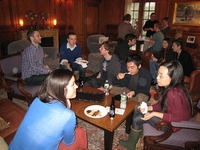Prof Gary King
These are slides I display in class while teaching, as well as videos of my lectures. My strategy is to go through as much material as possible at each lecture, subject to the constraint that everyone follows what I'm doing. The speed at which I go is therefore dependent on the composition of each year's class and the questions that arise. As such, the slides below are not broken up into distinct weeks (I seem to go through roughly 15-20 pages in a weekly session lasting almost 2 hours, but issues and topics not represented here are covered most weeks). Separate PDF versions appear for teaching (i.e,. with pauses, etc.) and for (color) printing. R code is provided for each section. I update these slides almost continuously while I teach. I'd appreciate if you would contact me with any comments, corrections, or suggestions.
- The basics. [to print]: Course introduction, What is the field of political methodology?, What is statistics?, notation, probability, probability densities, statistical simulation (First lecture notes for 2011 only: intro, [to print])
R Code for the basics.
- [video] Course Introduction (17:49)
- [video] What is Statistics? (24:24)
- [video] Statistical Models - Part 1 (15:31)
- [video] Statistical Models - Part 2 (32:51)
- [video] Simulation (11:34)
- [video] Probability Densities (16:57)
- [video] Bernoulli and Binomial Distributions (23:28)
- Theories of Inference. [to print]: alternative theories of inference (Bayes, likelihood, Neyman-Pearson hypothesis testing, etc.) R Code for theories of inference.
- [video] Problem of Inference and Likelihood Theory of Inference (36:34)
- [video] Bayesian Theory of Inference (22:14)
- [video] Neyman-Pearson Hypothesis Testing (13:03)
- [video] What is the Best Theory of Inference? (09:29)
- [video] Likelihood of Stylized Normal (28:44)
- [video] Hyperdimensional Space (11:04)
- [video] Finding Maximum of Likelihood (05:15)
- [video] Properties of Likelihood Maximum + Uncertainty (23:02)
- [video] Standard Errors of Maximum Likelihood Estimates (29:20)
- [video] Simulation for any Maximum Likelihood Model (08:37)
- [video] Forecasting Presidential Elections - Part 1 (18:42)
- [video] Forecasting Presidential Elections - Part 2 (21:01)
- [video] Variance Function Models (08:05)
- Single Equation Models. [to print]: binary variable models, interpretation and presentation via simulation, ordinal dependent variables, how do you know which model is better?, grouped binary variables, event counts, simple duration models and censoring. R Code for Single Equation Models
- [video] Logit Model - Part 1 (10:49)
- [video] Logit Model - Part 2 (17:42)
- [video] Alternative Interpretation of Logit Model (25:13)
- [video] Presenting Statistical Results - Part 1 (11:19)
- [video] Presenting Statistical Results - Part 2 (09:11)
- [video] Simulating Quantities of Interest and Associated Uncertainty (38:44)
- [video] Application of Clarify Package (06:18)
- [video] Ordinal Dependent Variable Models (26:01)
- [video] Model Validation - Part 1 (13:21)
- [video] Model Validation - Part 2 (25:51)
- [video] Grouped Uncorrelated Random Variables (20:20)
- [video] Event Count Models (27:37)
- [video] Duration Models: Exponential (17:38)
- Causal Inference
- Detecting Model Dependence. [to print]: Sensitivity to parametric assumptions, revealing inferences too far from the data to have empirical answers, the curse of dimensionality, extrapolation, measures of distance from the data.
- [video] Model Dependence (27:42)
- [video] Example of Model Dependence (Doyle and Sambanis, APSR 2000) (13:13)
- Matching Methods to Ameliorate Model Dependence. [to print]: Matching methods as nonparametric preprocessing to reduce model dependence in parametric causal inference.
- [video] Intro to Matching and Review of Model Dependence (06:02)
- [video] Matching as Solution to Model Dependence (27:23)
- [video] Matching and Causal Quantities of Interest (07:44)
- [video] 3 Methods of Matching (25:22)
- [video] Space Graphs: Visualizing Bias-Variance Tradeoff in Matching (17:30)
- [video] Reorientation on Matching Methods and Space Graphs (16:03)
- [video] Propensity Score Matching as Approximating Random Matching (15:57)
- [video] Problems with Popular Matching Methods and CEM as a Valuable Alternative (11:46)
- Research Designs. [to print]: an overview of how key features of various observational and experimental research designs, and the designs themselves, reduce components of error in estimating causal effects.
- [video] Causal Quantities of Interest and Error Decomposition (44:35)
- [video] Benefits of Major Research Designs (38:28)
- R Code for model dependence and matching.
- Multiple Equation Models
- Analysis Models. [to print]: identification, how multiple and single equation models differ, seemingly unrelated regression models, reciprocal causation, multiple equation reparametrization, multinomial choice models (multinomial probit, multinomial logit), independence of irrelevant alternatives, conditional logit.
- [video] Multiple Equation Models and SURM (27:17)
- [video] Reciprocal Causation (27:15)
- Missing Data Modeling. [to print]: problems with listwise deletion, assumptions, general purpose methods, application specific methods, multiple imputation, computational algorithms, a detailed example, Amelia software
- [video] Missing Data Notation and Setup (17:52)
- [video] Why is Listwise Deletion Bad? (13:36)
- [video] General Purpose Existing Methods for Missing Data (08:41)
- [video] Application-Specific Methods for Missing Data (11:27)
- [video] Multiple Imputation for Missing Data - Part 1 (06:23)
- [video] Multiple Imputation for Missing Data - Part 2 (15:40)
- [video] Computational Algorithms for Missing Data (15:21)
- [video] Amelia-Style Missing Data Imputation (16:20)
- R Code for multiple equation models and missing data.
- Text Analysis: Statistical analysis when the observation is a text document of some kind.
- Supervised Learning: Estimating the average in a category vs. individual classification, dealing with measurement error, extensions to an apparently unrelated application in epidemiology and public health Part I [to print].
- [video] Quantities of Interest in Text Analysis and Representing Text as Numbers (22:27)
- [video] Existing Statistical Approaches to Estimating Proportions in Categories (10:22)
- [video] Using Misclassification Rates to Correct Proportions (12:55)
- [video] Verbal Autopsy Methods (07:18)
- Unsupervised Learning: fully automated vs computer assisted cluster analysis; why humans are incapable of learning from text as well as computers & why computers can't do it without humans Part II (no 'to print' version).
- [video] New Strategy for Cluster Analysis (28:22)
- [video] Applications of Cluster Analysis (19:33)
- Time Series Fundamentals. [to print]: the basics of time series models.
- Rare Events
- Time Invariant Models. [to print]: Rare events, relationship to logistic regression, classic case-control research designs (how and why to select on the dependent variable), robust bayesian analysis, reporting standards in case-control studies, ReLogit software.
- Time Varying Models. [to print]: time varying quantities of interest; understanding hazard rates; exponential, Weibull, and Cox Proportional hazard duration models, density case control models.
- Cross-Cultural and Interpersonal Comparability in Survey Research.
- Part I. [to print]: Differential item functioning, measurement in survey research; modeling issues: random effects, conditional estimation, parametric methods, introduction to nonparametric methods.
- Part II. [to print]: Nonparametric methods.
- Ecological Inference. [to print]: Making inferences about individual behavior from aggregate, group-level data. History of the ecological inference problem, Goodman's model, the Davis-Duncan bounds, King's EI model, what can go wrong and what to do about it, and model extensions.
- More to come...
- See also public presentations



